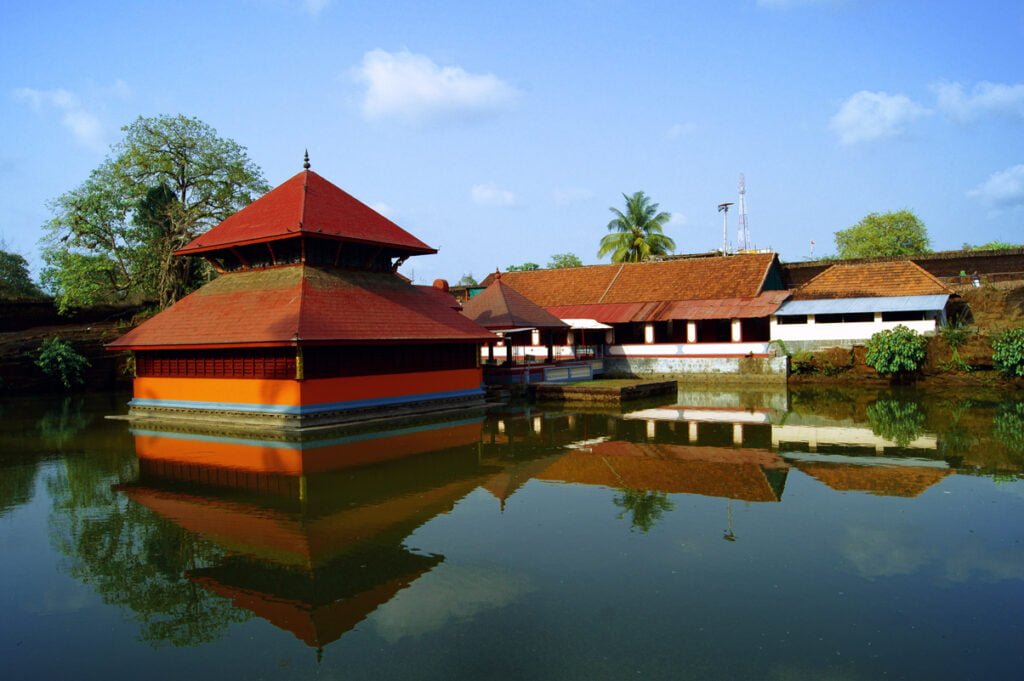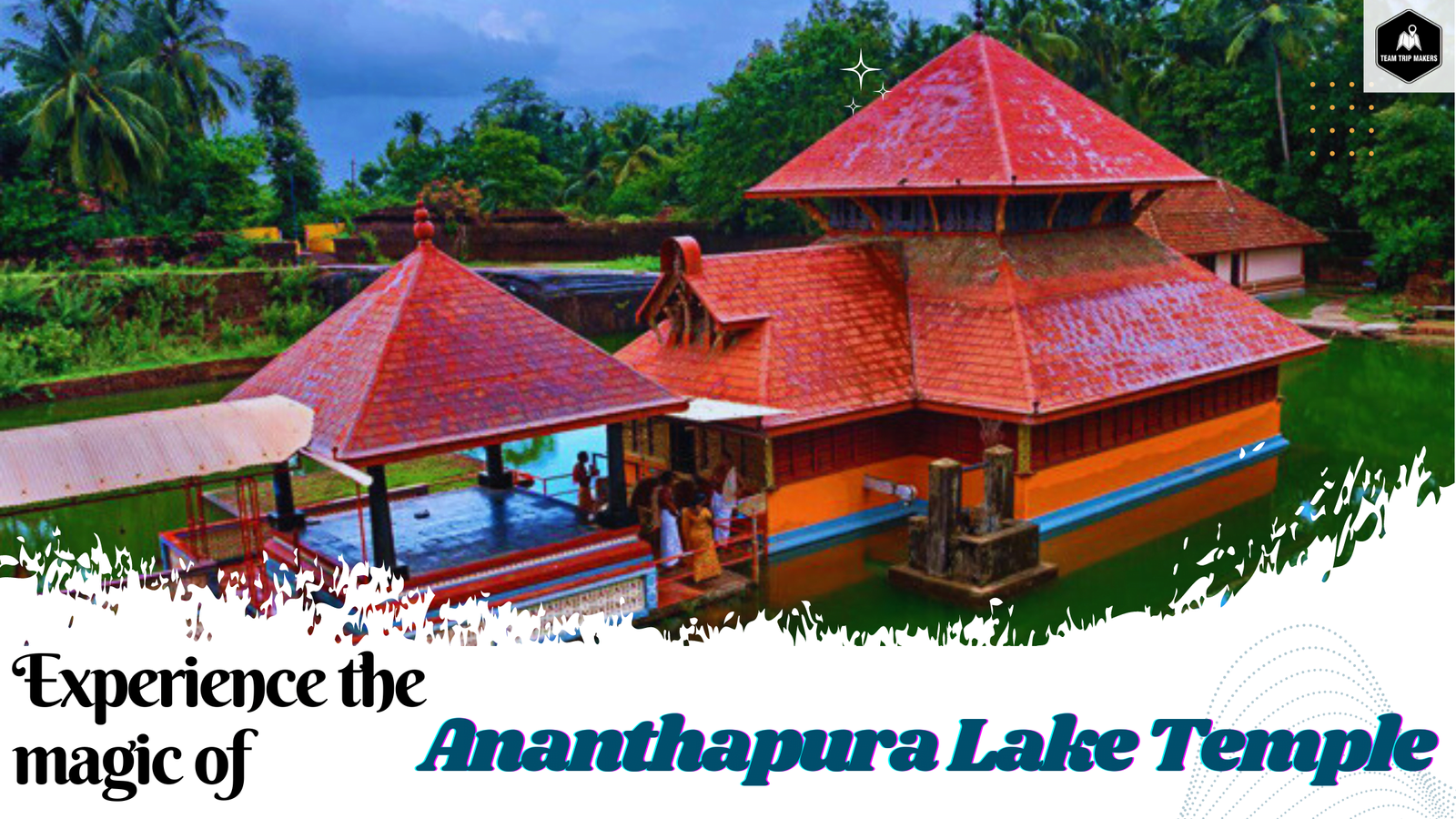Deep in the heart of Kerala’s Kasaragod district, nestled amidst verdant landscapes, lies a unique jewel – the Ananthapadmanabhaswamy Temple, also known as the Ananthapura Lake Temple. Unlike its more famous counterpart in Thiruvananthapuram, this 9th-century wonder resides serenely in the middle of a pristine lake, making it the sole lake temple in all of Kerala.
Legends and history intertwine beautifully here. Local traditions claim that this temple is the Moolasthanam, the original abode, of Lord Ananthapadmanabha, the very deity enshrined in the famed Sree Padmanabhaswamy Temple of Thiruvananthapuram. Imagine the connection – two temples bearing the same name, standing at opposite ends of the state, yet linked by their dedication to the reclining Vishnu.
Stepping into the temple grounds is like stepping back in time. The rectangular lake, measuring about 2 acres, shimmers with the reflection of the ancient structure. Believed to be constantly fed by natural springs, the water holds a special sanctity. As you explore the temple, take a moment to notice the intriguing cave located near the right (north) corner of the lake. Local folklore whispers tales of Lord Ananthapadmanabha choosing this very passage to journey all the way to Thiruvananthapuram. This captivating legend adds another layer of mystique to the temple’s aura.
Apart from its historical importance, the Ananthapura Lake Temple is a peaceful sanctuary. A serene atmosphere is created by the soft sound of the waves crashing against the temple walls and the verdant surroundings of the lake. People from all walks of life come here to immerse themselves in the spiritual atmosphere and ask for blessings.
There is more to the Ananthapura Lake Temple visit than just religion. Experience the essence of Kerala’s rich legacy, take in the distinctive architectural design of the area, and unwind in the company of the stunning natural surroundings. Therefore, don’t pass up the chance to discover this hidden jewel and all of its mysteries on your next trip to Kerala.
Structure and Deity
Beyond its serene setting, the Ananthapura Lake Temple boasts a unique architectural style. Rising majestically in the center of a 302-foot lake, the temple complex hints at a grander past. Ruins scattered around the lake suggest it was once part of a vast temple complex.
The heart of the temple lies within the lake itself. The sanctum (sreekovil), along with other structures like the Namaskara-mandapam and shrines, are all accessible via a footbridge. This unique layout adds to the temple’s mystique.
One fascinating aspect is the original idols, crafted from a rare medicinal concoction called “kadu-sharkara-yogam.” Though replaced with metal idols in 1972, efforts are underway to restore the original ones. The main deity, Lord Vishnu, sits serenely on the five-hooded serpent king Anantha.
For art enthusiasts, the temple offers a visual treat. The mandapam ceilings are adorned with exquisite wood carvings depicting scenes from Lord Vishnu’s ten incarnations (Dashavatharam). The mukha-mandapam features painted depictions of the nine planets (Nava-grahas), while the beautifully carved wooden dwaara-palakas (Jays and Vijaya) stand guard on either side of the sanctum sanctorum.

Babia: The Temple’s Gentle Giant (1947 – 2022)
Ananthapura Lake Temple wasn’t just home to a deity; it was also the domain of a beloved resident – Babia, the vegetarian crocodile. Unlike her ferocious counterparts, Babia held a unique place in the hearts of devotees. This gentle giant, estimated to have lived for over 75 years, was revered as a temple guardian, peacefully coexisting with the serene surroundings.
Legends swirled around Babia, the most captivating being her supposed vegetarianism. Devotees offered her temple prasadam (offerings) twice a week, a simple meal of cooked rice and jaggery. She readily accepted this vegetarian fare, further solidifying her special bond with the temple. This remarkable anomaly drew visitors from far and wide, eager to witness the unlikely friendship between a crocodile and a place of worship.
Sadly, Babia passed away in October 2022, leaving a void in the temple community. However, her memory lives on. For locals, she wasn’t just a crocodile; she was a gentle protector, a symbol of the temple’s unique spirit, and a testament to the harmonious relationship that can exist between humans and nature.
The Legend of the Temple
According to legend, the temple is connected to Sree Vilvamangalathu Swami, a famous mystic and devotee of Lord Vishnu, who rules over Kerala’s old spiritual lake. In actuality, his notoriety goes beyond Kerala’s boundaries. He is well-known as Bilvamgala in Bengal. The temple is referred to as the Moolasthanam of the Sri Padmanabha Swamy Temple in Thiruvananthapuram in a narrative involving Vilvamangalathu Swami.
While Sage Vilvamangalthu Swami was doing penance in the holy spot, Lord Krishna used to visit him disguised as a mischievous little boy. One day he did some pranks on him while the swamigal doing his pooja. Swamigal, at his wit’s end, admonished the child and pushed him with his backhand. The Lord, transformed into a ball of divine aura hastened through the cave. A divine voice echoed “Now if you want to see me, come to Ananthankadu”. Then only Vilvamangalathu Swami realized that the boy was none other than his own lord. It is said that the sage also ran into the cave and going through the passage that formed there he reached the Seashore and from there traveled southwards in search of Ananthankadu, At last, the sage reached a place that is the present location of Thiruvananthapuram, the capital of Kerala, where he had the splendrons vision of Lord Vishnu. It was at this holy spot Eventually Sri Anantha Padmanabha Swamy Temple of Thiruvananthapuram came up. On the northeast corner of the lake there is still a big cave with a small pit with a perennial presence of water in it, Which is considered as a sacred Theertham. It is beleivered to be the cave where boy Krishna disappeared.
Near the south-west corner of the Ananthapura lake, there is a shrine housing a very graceful idol of Sreekrishna belived to have been the same idol worshipped by Sri Vilvamangalathu Swamy. Refere the book Sree Padmanabha Swamy Temple written by Smt. Ashwathi Thirunal Gowri Lakshmi Bai of Travancore Royal Family.
Dress code
The dress code at Ananthapura Lake Temple in Kerala requires traditional Indian attire. Women can wear sarees or salwar kameez, and men can wear dhotis and kurta. Clothing that covers the shoulders and knees is suitable, with full-length clothing being ideal.
Timing
05.30 AM – 12.30 PM & 05.30 PM – 07.30 PM every day
Getting there
Nearest railway station: Kasaragod Railway station, on the Kozhikode-Madhur road, about 14 km.
Nearest airport: Mangalore Airport (Karnataka), about 56 km | Kannur International Airport, about 125 km | Calicut International Airport, about 222 km



